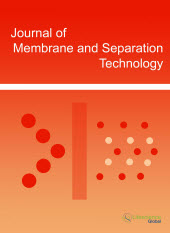jmst
Abstract : CO2 Permeation Behavior through Carbon Membranes: A Short Review of the Progress during the Last Decade
|
|
Abstract: Although carbon dioxide is not classified as a toxic or harmful gas the necessity for its capture is enforced not only by scientists but also by governments worldwide. In this attempt the technologies which are proposed to attend this role are various. Contrary to the traditional thermal methods (distillation, adsorption, cryogenic), which require high energy sources, the membrane technology seems to be the prevalent solution mainly thanks to its low operation cost. To this aim, both polymeric and inorganic membranes are reported as good candidates for CO2 separation–capture. The main advantages of the inorganic membranes, in terms of the polymeric, are their higher selectivity factors and the better stability at both high temperatures and chemical environments. The preparation of the carbon membranes takes place mainly by the controlled pyrolysis of different thermosetting polymeric materials and the final configuration can be divided into the following configurations: i) flat sheet membranes, ii) supported on tube membranes, iii) capillary membranes and iv) hollow fiber membranes. During the last fifty years, more attention has been devoted, not only for the simultaneous increase of both permeability and selectivity factors but also for the large–scale production of crack free carbon membranes. The reproductivity is also one critical point which has to be achieved if we really aim for the industrial application of the carbon gas selective membranes. Therefore, carbon membranes have the potential to be the materials of the future for many gas separation processes including the one of carbon dioxide separation–capture. This paper is reviewing the development and the achievements of the carbon membranes in the direction of the CO2 separation giving emphasis on the last 10 years. Keywords: CO2 permeation, CO2 selectivity, inorganic membranes, carbon membranes, gas separation.v. Download Full Article |
Abstract : Combination of Adsorption-Diffusion Model with Computational Fluid Dynamics for Simulation of a Tubular Membrane Made from SAPO-34 Thin Layer Supported by Stainless Steel for Separation of CO2 from CH4
|
|
Abstract: Modeling of CO2/CH4 separation using SAPO-34 tubular membrane was performed by computational fluid dynamics. The Maxwell-Stefan equations and Langmuir isotherms were used to describe the permeate flux through the membrane and the adsorption-diffusion, respectively. Three-dimensional Navier-Stokes momentum balances in feed and permeate side coupled with adsorption-diffusion equations from the membrane were simultaneously solved by ANSYS FLUENT software. The velocity and concentration profiles were determined in both feed and permeate sides. There was a good agreement between simulation and experimental results and root mean square deviation for CH4 and CO2 are 0.13 and 0.1 (mmol m-2 s-1), respectively. The concentration polarization effect was observed in the results. The effect of the process variables were investigated to find out the most influential parameters in permeation and purity. The impact of operating conditions on separation were studied and showed that for enhancement of separation efficiency of CO2 from CH4, feed pressure, feed flow rate and tube radius and number of membrane modules in series should be increased, whereas flow configuration has less significant effect. Keywords: Computational fluid dynamic, tubular zeolite membrane, CO2/CH4 separation, SAPO-34, Adsorption-diffusion mechanismv. |
Abstract : Colloidal Silicalite Coating for Improving Ionic Liquid Membrane Loading on Macroporous Ceramic Substrate for Gas Separation
|
|
Abstract: Athin layer of colloidal silicalite was coated on a macroporous alumina substrate to improve the effectiveness in loading and supporting ionic liquid (IL) membrane on macroporous ceramic substrate. The [bmim][BF4] IL and CO2 gas separation were used as the model system in this research. The colloidal silicalite top layer enabled the formation of a pinhole-free IL membrane with significantly reduced load of IL as compared to the bare alumina substrate because the former had a smaller and more uniform inter-particle pore size than the latter. The supported IL membrane was extensively studied for CO2 separation in conditions relevant to coal combustion flue gases. The silicalite-supported IL membrane achieved a CO2/N2 permselectivity of ~24 with CO2 permeance of ~1.0×10-8 mol/m2·s·Pa in dry conditions at 26˚C and reached a CO2/N2 separation factor of ~18 with CO2 permeance of ~1.56×10-8 mol/m2·s·Pa for a feed mixture containing ~11% CO2 and ~9% water vapor at 50oC. This supported IL membrane exhibited excellent stability under a 5-bar transmembrane pressure at 103˚C and chemical resistance to H2O, SO2, and air (O2). Results of this study also indicated that, in order to fully realize the advantages of using the colloidal silicalite support for IL membranes, it is necessary to develop macroporous ceramic supports with optimized pore size distribution so that the IL film can be retained in the micron-thin silicalite layer without penetrating into the base substrate. Keywords: Colloidal silicalite, ionic liquid, membrane, carbon dioxide, separation. Download Full Article |
Abstract : Characterisation of Mass Transfer in Frontal Nanofiltration Equipment and Development of a Simple Correlation
|
|
Abstract: This aim of this work was to investigate the effects of mass transfer in three commercially available frontal nanofiltration systems (Amicon, Sterlitech and Membranology) using the rejection of uncharged poly ethylene glycol (molecular weight 3400) at different pressures and stirrer speeds using a 4000 MWCO membrane. The real rejection was calculated from the observed rejection using the infinite rejection method and a comparison was made between experimentally obtained mass transfer coefficients and those obtained from commonly used ultrafiltration theory. A new mass transfer correlation was proposed that is more appropriate to account for the increased mass transfer effects observed with the larger pressures of nanofiltration. This new correlation is defined as NSh = φ(NRe)n (NSc)0.33 [1+[JV/ωr]X] is only a minor modification to existing theory and has an accuracy suitable for engineering design purposes. Keywords: Mass transfer, Concentration polarisation, Equipment characterisation, Frontal filtration, Nanofiltration.Download Full Article |






















